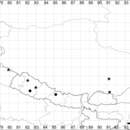Description
provided by Phytokeys
(based on the specimens growing in our area): Annual up to 100 cm, almost glabrous or only slightly mealy in the upper part. Leaf axils with numerous fertile or sterile brachyblasts. Leaves long-petiolate, continuously shortening upwards; petioles 3.0–10.0 cm; blades 4.0–10.0 cm long, triangular-hastate, entire or with 1–2 unequal lateral lobes in lower part of the leaves, apex attenuate (similar to the leaves of Atriplexmicrantha C.A.Mey.). Inflorescence leafy or bracteose, consisting of short lateral branches with scattered yellow glands. Perianth segments halfway connate, slightly keeled in the upper part or smooth; margins in the upper part of the segments covered with bladder hairs intermixed with scattered simple hairs. Fruit 1.3–1.8 mm (usually 1.4–1.7 mm) long, 0.9–1.1 mm thick, pericarp brownish, easily ruptured at maturity, slightly alveolate or smooth in dry fruits (with tiny papillae in fresh or soaked fruits). Seed depressed globular, black, keeled, shiny, rugulose, with sinuous surface as well as scattered indistinct longitudinal striae with shallow pits (Fig. 13C, D).
- license
- cc-by-3.0
- copyright
- Alexander P. Sukhorukov, Pei-Liang Liu, Maria Kushunina
- bibliographic citation
- Sukhorukov A, Liu P, Kushunina M (2019) Taxonomic revision of Chenopodiaceae in Himalaya and Tibet PhytoKeys (116): 1–141
- author
- Alexander P. Sukhorukov
- author
- Pei-Liang Liu
- author
- Maria Kushunina

